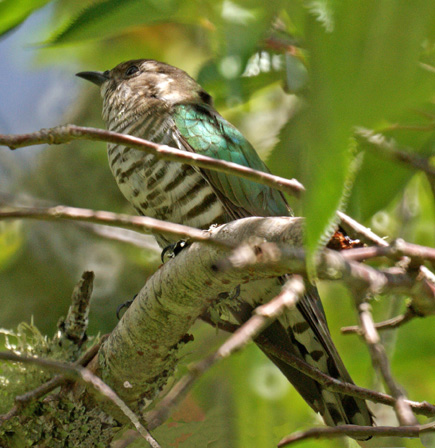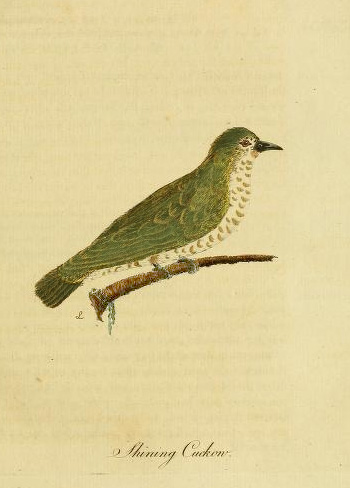


Pipiwharauroa, the shining cuckoo; Photographer: Peter Woods
Walking my dog along the river every morning, I listen for the call of Pipiwharauroa, the shining cuckoo, and am greatly disappointed if it doesn’t occur. Their voice starts like someone whistling for their dog and then tails off into a series of downward notes like a long sigh. Trying to follow the call to identify the bird can be a frustrating experience as it is very deceptive. The bird can be quite close without one knowing as the call starts off quietly as if a long way away, so they are difficult to actually sight.
However, I have been lucky in that they usually frequent the kowhai trees in the garden here and so I have often watched them meticulously searching through the tree at my kitchen window for the larvae of the kowhai moth. They are, I think, instrumental in keeping the kowhai trees around here very healthy. But this year I have only seen them twice which makes me fear their numbers are decreasing but hopefully I have just not been so observant. The bird is about the size of a sparrow and is wonderfully marked with an iridescent greenish blue coat above a striped off-white body. Their diet consists almost entirely of insects and their larvae and includes the hairy caterpillar of the magpie moth which is avoided by all other birds.
Last year I had the privilege of watching Riroriro, the grey warbler, feeding a fledgling shining cuckoo which was crying incessantly in one of the kanuka trees behind the hay barn. And later while walking along the road I found a pair feeding two birds. Luckily for them the coprosmas which hang over the road were infested with one of the shield beetles, otherwise I could not imagine how they could have fed such squawking monsters. My impression is, however, that the grey warbler, far from thinking rearing this bird to be a burden, seems quite proud of its prodigous adopted offspring for I have watched a pair of grey warblers following around a fully fledged young cuckoo, watching over it while it looked for food in the kowhai trees.
Like other cuckoos, the shining cuckoo neither builds its nest nor rears its young. It leaves this job to the grey warbler who manages to rear one clutch of its own before the cuckoo arrives here around September from the Solomon Islands and the Bismarck Archipelago.
This last spring I thought they were late arriving here and got quite panicky when I heard about the forest fires in South East Asia. I thought that they may have got caught up in all that terrible smog but an e-mail to Kevin Smith of Forest and Bird reassured me, although he thinks the logging in the Solomons will inevitably have an effect upon their numbers.
There is probably no doubt that the scarcity of insects in the winter has been behind the evolutionary drive for the shining cuckoo to migrate. They leave around February or March and follow a route north which is not clear. They may follow a different route from their spring migration. On leaving their winter quarters many, if not most, birds, make their way down the eastern Australian coast before flying across the Tasman to New Zealand. Immature birds may travel the same route in reverse while adults may make a more direct flight of over 3000 km over the Pacific Ocean when trade winds could give some assistance. They have been recorded on Lord Howe and Norfolk Islands during the migration seasons.
If the cuckoo’s migration path is a bit of a mystery, how it’s egg gets into the grey warbler’s nest is another. The grey warblers build a covered, hanging nest with a small circular entrance which is just too small for the cuckoo to enter without damaging the nest. However, in the September, 1991, Nortornis, the official publication of the New Zealand Ornithological Society, there is a photo of a cuckoo carrying an egg in its beak. In my view, this seems the most likely way in which the egg is placed in the warbler’s nest.
Maori tradition believed the shining cuckoo wintered in Hawaiki, which indicates that they were well aware of the bird’s migratory habits. However, it was probably from observing the long tailed cuckoo, Koekoea, which winters chiefly in Fiji, Tonga, Samoa, Cook, Society and Tuamotu groups, which lead the voyaging ancestors of Maori to believe that there was land to the south.
European tradition regarding cuckoos is quite different as is revealed by a song of Shakespeare’s: “The cuckoo then, on every tree, mocks married men; for thus sings he, cuckoo!”
NOTE:
For additional information about Pipiwharauroa use this link to the Pipiwharauroa page listed in the Maori myths section.


Pipiwharauroa, the shining cuckoo from John Latham's, General Synopsis of Birds, 1795.
| Taxonomy | |
|---|---|
| Kingdom: | Animalia |
| Phylum: | Chordata |
| Class: | Aves |
| Order: | Cuculiformes. |
| Family: | Cuculidae. |
| Genera: | Chrysococcyx. |
| Species: | lucidas. |
| Sub Species: | lucidas. |
Native bird
16 cm., 25 g., metallic bronze green, barred dark green on white face and underparts.
Widespread and quite common.
Pipiwharauroa, the shinning cockoo
LINK to the Maori myth section
Song of: — Pipiwharauroa, the shinning cuckoo
Viking Sevenseas
Poetry: —
When daisies pied, and violets blue,
And lady–smocks all silver–white,
And cuckoo–buds of yellow hue
Do paint the meadows with delight,
The cuckoo then, on every tree,
Mocks married men, for thus sings he:
’Cuckoo!
Cuckoo, cuckoo!’ O word of fear,
Unpleasing to a married ear.
When shepherds pipe on oaten straws,
And merry larks are ploughmen’s clocks,
When turtles tread, and rooks, and daws,
And maidens bleach their summer smocks,
The cuckoo then, on every tree,
Mocks married men, for thus sings he:
’Cuckoo!
Cuckoo, cuckoo!’ O word of fear,
Unpleasing to a married ear.
— Willam Shakespeare,
from Love’s Labour’s Lost
The Pipiwharauroa
I remember once in Para how I heard your mother calling
Calling “Pip–wha–rau–roa” from a poplar by the river,
Crying slowly the one word.
And I burnt my eyes from gazing. Still I see the poplars shiver,
Still I hear the little runnels down the folded gully falling,
But I never saw the bird.
But I heard what you have heard not, for I heard your mother crying,
Crying out for Spring the Leafy, Spring the Slender, Spring the Comer,
Of the manuka and dew.
Who would dream that in her treason she would follow after Summer,
With her nestlings unattended, gaily after Summer flying,
And no thought at all of you.
Why, then, foolish little fledglings, do you ever seek to follow?
What old meekness makes you follow that strange one that gave you over,
Nor remembered you a day?
Are the seas to you as homely as our fields of curling clover?
What old memory sends you blindly over hill and over hollow?
Do you ever doubt the way?
But I lose my time in wonder, for you, too, in Spring returning,
Will cry “Pipi–wha–rau–roa” from the poplar by the river,
Loving Spring in every word.
You will cheat the little warbler, and to other shorelines turning,
You will fly away forgetting, with your careless wings a-quiver.
Fly, then, faithless little bird.
— Eileen Duggan
Reading: —
LISTEN to The Pipiwharauroa
— by Eileen Duggan
— read by Narena Olliver
Peter Woods
While visiting NZ from the UK
Nov. 2009, Cornwall Park, Auckland
Latham, John, General Synopsis of Birds, 1795.
Heather, B., & Robertson, H., Field Guide to the Birds of New Zealand, 2000.
Oliver, W.R.B., New Zealand Birds, 1955.
Saturday, 29 July, 2023; ver2023v1